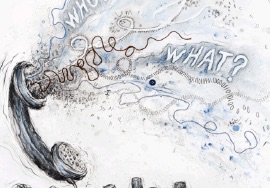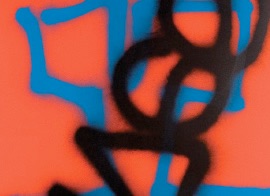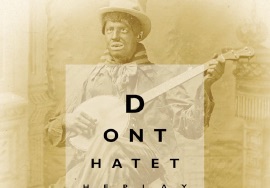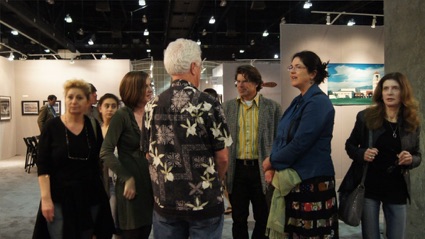The artists featured in this Letters from Los Angeles exhibition have used text in extraordinarily diverse ways: immortalizing L.A.'s signs, streets, and gas stations; using comic book captions to convey dramatic angst, juxtaposing text with appropriated images; framing collages with wry observations and titles; surrealist re-configuring of old prints and clippings with snatches of verse and prose, employing the power of language to pose disquieting comments in conceptual works, often dealing with anti-war, racial, and gender issues. The range of approaches is as individual as the artists themselves. The vast and diverse ways that Southern California artists incorporate words, numerals, and text reflects an aesthetic that might even be seen as a logical antecedent to the current spotlight on contemporary graffiti and tattoo art.
Since the 1960s, text in the art of L.A. was most popularized by Edward Ruscha, whose works are included in this exhibition. Letters from Los Angeles also includes works from the artist whose works were most ubiquitous in the 1960s - Corita Kent (1918-1986). Concurrent with the LA Art Show, Corita Kent's works are the subject of a major retrospective exhibition at the Tang Museum at Skidmore College in New York, presented through the support of the Andy Warhol Foundation. Quoting the Warhol Foundation: "... Sister Corita, who achieved fame in the 1960s as a liberal activist artist nun ...incorporated text borrowed from a wide variety of sources, from advertising to literature to scripture. …their ingenious textual amalgams exhort viewers to create a better society, and mix secular and religious, pop culture and fine art, suffering and joy. As such they are a vibrant expression of the contradictions and enthusiasms of sixties culture."
Theirs was by no means the first extensive use of typography in L.A. contemporary art. For example, from 1955 to 1964, Wallace Berman (1926-1976) brought typography and poetry together in a distinct and provocative way though a loose-leaf, free form art and poetry series entitled "Semina."
This now rare collection of "Semina" would ultimately be reconstructed [shown in this exhibition] by an artist closely associated with Berman, George Herms, one of the most significant collage artists to emerge from that generation.
In painting, while text can be seen in the anti-war canvases of Hans Burkhardt (1904- 1994), as well as in his paintings reacting to the Hollywood labor wars at the end of WW II, this exhibition includes Burkhardt's Basel Graffiti paintings of 1981, before the term "graffiti" was generally considered in the realm of fine art.
Burkhardt's extraordinary paintings were not graffiti art in and of themselves, but rather, formidable statements about graffiti and the plight of the street markmakers he encountered during travels to Basel, Switzerland. Burkhardt's paintings are powerful reflections upon the urban landscape he witnessed; however, more directly, they capture the angst, as well as the hope, of a generation five decades younger than Burkhardt. With astounding expressionist verve, Hans Burkhardt's are the most painterly works in Letters from Los Angeles.
A particularly fitting location, The LA Art Show's exhibition, Letters from Los Angeles: Text in Southern California Art begins immediately upon entering the Los Angeles Convention Center where two monumental works – terrazzo floors by Alexis Smith - reside. The South Hall Lobby of the Convention Center features an expansive map of the Pacific Rim. Spanning 50,000 square feet, this work is inset with medallions depicting cultural motifs from Pacific Rim cultures. The Convention Center's South Hall Lobby floor reveals Smith's night sky on its two levels. Whether viewed in close proximity by standing within their space or by engaging them from an upper vantage point, they are remarkable for their beauty.
Artists included in Letters from Los Angeles: Text in Southern California Art are: Lita Albuquerque, John Baldessari, Bill Barminski, Wallace Berman, Chris Burden, Hans Burkhardt, Huguette Caland, Greg Colson, Doug Edge, Mark X Farina, Jud Fine, Eve Fowler, Gajin Fujita, Alexandra Grant, Scott Grieger, Mark Steven Greenfield, Raul Guerrero, George Herms, Iva Hladis, Dennis Hopper, Ed Kienholz, Lynn Hanson, Charles LaBelle, Mark Licari, Michael C. McMillen, Jim Morphesis, Ed Moses, Bruce Nauman, Stas Orlovski, David Allan Peters, Paulin Paris, Raymond Pettibon, Lari Pittman, Ken Price, Bruce Richards, Ed Ruscha, Richard Shelton, Alexis Smith, Masami Teraoka, J. Michael Walker, Tom Wudl, and others.
While Los Angeles’ international recognition is acknowledged via text, it must be noted that Angelinos also self-identify with text, as no other city in the world refers to itself in both the written and spoken word so distinctly and interchangeably as we do with the initials: “L.A.”
Letters from Los Angeles offers but one aspect of Los Angeles' history. At a time when many have mythologized the contemporary art of this city into a neat simple equation or school or group of artists, such as those associated with the important Ferus Gallery of the 1960s, we recognize this amazing and expansive realm of L.A. history. It might very well be regarded as "Ferus' Day Off." *
Jack Rutberg
*Ferris Bueller's Day Off – 1986 Paramount Pictures', now classic coming of age comedy film written and directed by John Hughes, starring Matthew Broderick
The LA Art Show is entirely unique in the art world, juxtaposing contemporary works alongside historic and traditional to show movements and highlight the evolution of art through the ages. The LA Art Show provides seasoned collectors with a complete art experience through an expansive breadth of galleries that crosses contemporary, historic and print genres, and gives emerging collectors an opportunity to view a wide variety of works as they discover genres.
The show’s diverse array of artworks and galleries have been carefully curated and grouped into digestible sections. In essence, the LA Art Show is four distinct sections under one roof. The Modern & Contemporary Section, The Historic & Traditional Contemporary Section, The Los Angeles IFPDA Fine Print Fair & The Vintage Poster Section have been honed with the collector in mind. Unique in atmosphere, the aesthetics of each section have been designed to complement the art and create an immersive environment for collectors.
Featuring poured concrete floors and white wall, the contemporary section provided an ideal backdrop for works by Shepard Fairey, Damien Hirst, Christobal, Botero Jim Dine, Ed Ruscha, and others. With brilliant blue, green and grey felted walls against slate carpet, The Historic & Traditional Contemporary Section focused on historic works with their contemporary counterparts that embrace traditional techniques. Historic & traditional works included works by: Edgar Payne, Jesse Arms Botke, Joan Miro, Paul Gustav Fischer, Pierre Auguste Renoir, Marc Chagall, Tony Peters and others.









